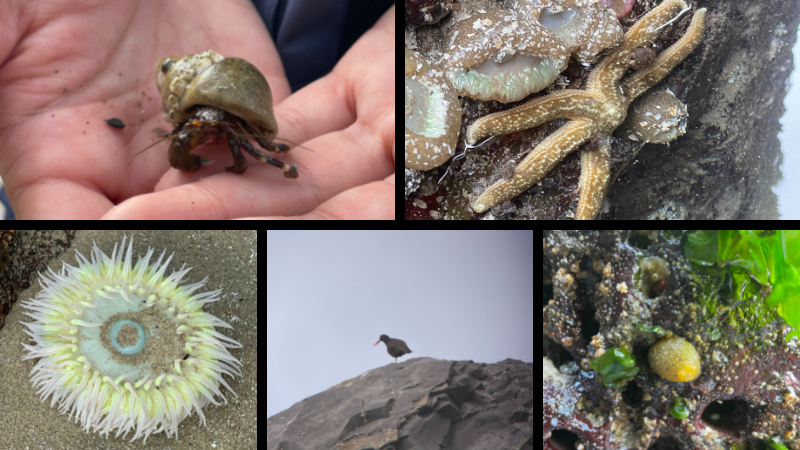
Angela Whitlock, one of the Tidepool Ambassador Program (TAP) leads, shares about anemones.
The rocky intertidal zones along the Oregon Coast—including Cape Falcon Marine Reserve—are teeming with biodiversity. Yet not everyone is aware of the abundance of living organisms inhabiting tidal pools.
That’s where the Tidepool Ambassador Program (TAP) volunteers come in.
Their job is talking to beach visitors and educating them on what is living in the tide pools and how to respectfully interact with these sensitive marine habitats. The goal, say TAP lead Angela Whitlock, is “to connect the visitor with the environment.”
“When you establish that relationship and make that connection, then you start caring,” she adds.

‘Every square inch is living’
The Tidepool Ambassador Program was introduced in 2021 as a joint effort between the “friends of” groups for Cape Falcon Marine Reserve, Cape Perpetua Marine Reserve, and the Cape Perpetua Collaborative. During the pilot year, trained volunteers interacted with more than 1,400 folks at the Cape Falcon site. It has returned here for a second year through North Coast Land Conservancy’s marine reserve program.
The 2022 season kicked off with a training at Haystack Rock in Cannon Beach on June 4, co-sponsored by the Haystack Rock Awareness Program (HRAP). It is running this summer from July to September at Short Sand Beach, in Oswald West State Park, which is adjacent to the marine reserve site.
Nearly a dozen volunteers have divvied up 18 weekend shifts surrounding the lowest tides of the season. They typically are the busiest days with the heaviest use, Angela says. During their shift, the volunteers connect with beach-goers and share information about proper tide pool etiquette.
Based on past interactions, Angela believes there is further work to be done in raising awareness and influencing positive behaviors.
“People who have been visiting now here for many, many years—myself included—we have a way we used to do things,” she says.
They may be used to climbing over the rocky tide pools or handling the sea creatures who reside there. However, as visitation to the Oregon Coast perpetually increases, the tide pools don’t have a chance to bounce back from this disruptive contact. Meanwhile, research shows the tide pools are less resilient than they used be for several reasons, including rising sea temperatures, pollution and ocean acidification.
“They’re extra delicate,” Angela says. TAP volunteers answer questions and help visitors understand that “every square inch is living” in order to minimize harmful impact from careless behaviors.

Lisa Habecker, Education and Volunteer Coordinator from the Haystack Rock Awareness Program (HRAP), leads the training in the tide pools at Haystack Rock
Raising lasting awareness
Angela recalls one of her highlights from last year, when she got to share with a young child about the biodiverse organisms residing in the tide pools. She then witnessed him speaking with another visitor and cautioning them about stepping on the rocks.
“I got to see, in action, this kid take the information and do good with it,” she says.
The volunteers also educate visitors on the types of species that thrive at Cape Falcon Marine Reserve based on its specific characteristics and habitat. This includes an array of anemone species, such as giant green and aggregating; nudibranchs; sea stars; barnacles; crabs and much more.
Although the program is currently running only at one spot within the marine reserve site, Angela sees it as merely the first step in spreading awareness and making it stick.
“Hopefully people take the information they’ve learned, and if they go to other rocky intertidal areas, they know how to treat them with respect, even if there’s no program there,” she says.
Comments